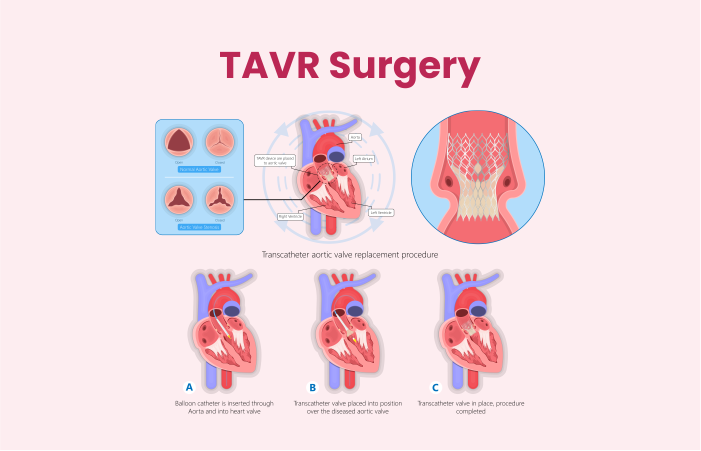TAVR Surgery in Hyderabad

Transcatheter Aortic Valve Replacement Surgery
Welcome to TX Hospitals, the leading destination for Transcatheter Aortic Valve Replacement (TAVR) surgery in Hyderabad. We are dedicated to providing exceptional cardiac care and offer advanced treatment options for patients with heart valve conditions. Our experienced team of doctors specializes in TAVR procedures, including the highly sought-after Transcatheter Aortic Valve Implantation (TAVI). In this article, we will provide you with valuable information about TAVR surgery, including its purpose, why it is performed, how to prepare for the procedure, and the consequences of delaying Transcatheter Aortic Valve Replacement Surgery.

What is Transcatheter Aortic Valve Replacement Surgery?
Transcatheter Aortic Valve Replacement (TAVR) surgery is a minimally invasive procedure used to treat aortic valve stenosis. During the surgery, a damaged or narrowed aortic valve is replaced with a prosthetic valve using catheter-based techniques. This innovative approach eliminates the need for traditional open-heart surgery, resulting in faster recovery times and reduced risks.
Why is Transcatheter Aortic Valve Replacement Surgery Performed?
Transcatheter Aortic Valve Replacement Surgery is performed to improve the functioning of a diseased or narrowed aortic valve. It is particularly beneficial for patients who are considered high-risk or ineligible for traditional open-heart surgery. TAVR provides a viable treatment option that improves symptoms, enhances quality of life, and extends survival rates.
How to Prepare for Transcatheter Aortic Valve Replacement Surgery?
Preparing for TAVR surgery involves several important steps. Your healthcare team at TX Hospitals will guide you through the process, ensuring a smooth and successful experience. Here are some general guidelines to help you prepare:
- Consultation: Schedule a consultation with our TAVR experts. They will evaluate your condition, perform necessary tests, and discuss the procedure’s benefits, risks, and expected outcomes.
- Medical Evaluation: Undergo a comprehensive medical evaluation to assess your overall health and identify any underlying conditions that may affect the surgery or recovery process.
- Pre-operative Instructions: Follow the pre-operative instructions provided by your healthcare team, which may include fasting before surgery, stopping certain medications, and arranging for transportation to and from the hospital.
- Lifestyle Adjustments: Your doctor may recommend certain lifestyle adjustments, such as quitting smoking, maintaining a healthy diet, and engaging in regular exercise, to optimize your overall health before the surgery.
More About Transcatheter Aortic Valve Replacement Surgery at TX Hospitals
At TX Hospitals, we are proud to offer state-of-the-art facilities and a highly skilled medical team specializing in TAVR procedures. Our commitment to excellence ensures that you receive the highest standard of care throughout your treatment journey. We utilize advanced medical technologies and adhere to rigorous safety protocols to achieve optimal outcomes for our patients.
Consequences of Delaying Transcatheter Aortic Valve Replacement Surgery
Delaying TAVR surgery can have serious consequences, as aortic valve stenosis can worsen over time, leading to symptoms such as chest pain, shortness of breath, fatigue, and even heart failure. It is essential to consult with our TAVR experts at TX Hospitals to assess your condition and determine the most appropriate timing for surgery. Timely intervention can prevent further complications and improve your overall cardiac health.
Choose TX Hospitals for Transcatheter Aortic Valve Replacement Surgery
When it comes to Transcatheter Aortic Valve Replacement Surgery, TX Hospitals is your trusted partner for exceptional care and successful outcomes. Our dedicated team of cardiac specialists, cutting-edge technology, and patient-centric approach make us the best choice for TAVR surgery in Hyderabad.
Contact us today to schedule a consultation and take the first step towards improving your cardiac health. Our team will provide you with the personalized attention and comprehensive care you deserve, ensuring a smooth and successful TAVR experience. Experience the excellence of TX Hospitals for Transcatheter Aortic Valve Replacement Surgery.
Frequently Asked Questions (FAQs)
TAVR is a minimally invasive surgical procedure used to treat aortic valve stenosis, a condition where the aortic valve becomes narrowed and restricts blood flow from the heart. Instead of open-heart surgery, TAVR involves inserting a replacement valve through a catheter, typically via a blood vessel in the leg.
TAVR is often recommended for patients with severe aortic valve stenosis who are considered high-risk or ineligible for traditional open-heart surgery due to age, medical conditions, or other factors. The suitability for TAVR depends on individual medical assessments.
During TAVR, a catheter with a collapsed replacement valve is inserted into a blood vessel, often through the femoral artery in the leg. The catheter is guided to the heart and positioned within the diseased aortic valve. The new valve is then expanded, pushing aside the old valve and restoring proper blood flow.
TAVR is generally considered a safer option for patients who are not good candidates for open-heart surgery due to its minimally invasive nature. However, the choice between TAVR and surgery depends on the patient’s individual health condition and risk factors.
Benefits of TAVR include shorter recovery times, smaller incisions, reduced risk of complications, and a quicker return to daily activities compared to traditional open-heart surgery.









